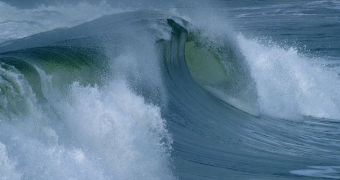A recent paper in the journal Geophysical Research Letter announces a world first for research projects focusing on the natural world and on how climate change and global warming are reshaping nature as we know it.
In a nutshell, the paper in question details how, using a high-tech sensor anchored to the seafloor, scientist Jim Thomson and fellow researchers managed to measure the height of humongous waves in the Arctic Ocean.
As detailed in a press release concerning this investigation, the sensor that Jim Thomson and colleagues employed was put to work trying to establish the size of waves in this part of the world between mid-August and late October 2012.
During this time, the sensor sat at a depth of roughly 50 meters (a little over 150 feet) in the Beaufort Sea, at a distance of about 350 miles (about 217 kilometers) from Alaska's north slope, Jim Thomson and fellow researchers explain.
While monitoring water movements in said marginal sea of the Arctic Ocean, the sensor successfully detected ginormous waves that stood about 5 meters (approximately 16 feet) tall. The waves were documented during a storm in September 2012.
To help put things into perspective, University of Washington researcher Jim Thomson and his colleagues explain that these waves that the sensor picked up on were about the size of a run-off-the mill house.
The scientists say that, contrary to what some might assume, investigations like this one are not a complete waste of time. On the contrary, they help shed new light on how climate change and global warming are reshaping the natural world.
Thus, the researchers say that, as the Arctic is melting, humongous waves like the ones documented in September 2012 in the Beaufort Sea are bound to become common sight. This constitutes a threat to coastlines and even to oil and gas companies looking to exploit this region.
“Almost all of the casualties and losses at sea are because of stormy conditions, and breaking waves are often the culprit,” Jim Thomson says. “As the Arctic is melting, it’s a pretty simple prediction that the additional open water should make waves,” the University of Washington specialist adds.
Interestingly enough, the formation of such big waves in the Arctic Ocean is expected to also push sea ice loss into overdrive. As Jim Thomson puts it, “What we’re talking about with the waves is potentially a new process, a mechanical process, in which the waves can push and pull and crash to break up the ice.”
The scientists behind this research project are now looking to deploy several more sensors like the one used in 2012 all across the Arctic Ocean. Information obtained with the help of these sensors is expected to shed new light on how the Arctic is responding to climate change and global warming.

 14 DAY TRIAL //
14 DAY TRIAL //